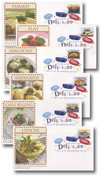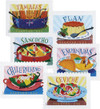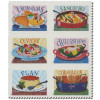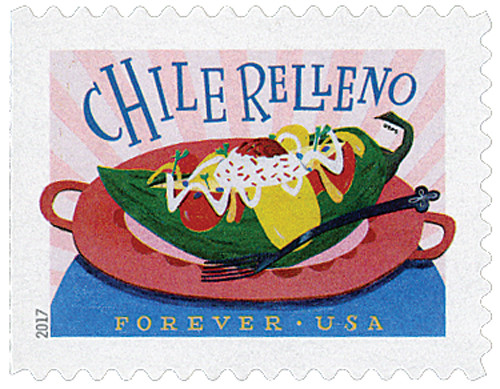
# 5192-97 - 2017 First-Class Forever Stamp - Delicioso
US #5192-97
2017 Delicioso
• Commemorates Latin American culinary traditions and how those traditions have impacted the food industry in the United States
Stamp Category: Commemorative
Value: 49¢ First Class Mail (Forever)
First Day of Issue: April 20, 2017
First Day City: Albuquerque, New Mexico
Quantity Issued: 200,000,000
Printed by: Banknote Corporation of America
Printing Method: Offset, Microprint
Format: Double-sided Booklets of 20
Tagging: Phosphor Tagged Paper, Block
Why the stamps were issued: To celebrate the influence of Central and South American, Mexican, and Caribbean cultures on American cuisine.
About the stamp designs: Includes six designs picturing artwork by John Parra of: tamales, flan, sancocho, empanadas, chile relleno, and ceviche. The designs are bright and colorful with the name of each dish at the top of the each stamp.
First Day City: The First Day of Issue Ceremony was held at the National Hispanic Cultural Center in Albuquerque, New Mexico.
History the stamp represents: In all areas of the world, a culture’s history can be traced through its food. Latin America is a prime example, blending the ingredients and traditions of indigenous people with those of Spanish settlers.
Before Spanish settlement, the Latin American diet mainly consisted of maize, cactus, avocados, beans, chilies, tomatoes, limes, potatoes, turkey, duck, deer, rabbit, and fish. Among the most enduring pre-colonial dishes is the tamale (a dough wrapped and steamed in a corn husk) that has been eaten for thousands of years.
The arrival of Spanish settlers in the 1500s led to major changes. They brought their favorite recipes, including sancocho (a soup or stew), empanadas (a meat-stuffed pastry), ceviche (a raw fish soup), and flan (a sweet custard). Along with these recipes, the Spanish brought new crops – garlic, onions, and rice – plus new livestock – chickens, cows, and pigs – as well as cheese. Some dishes, such as chile relleno (a stuffed pepper), were created during the settlement era, combining the best of both cultures’ culinary traditions.
Over time, the people of Latin America incorporated Spanish elements in their traditional foods and added fresh local ingredients to Spanish dishes. These dishes can vary by region and even family. The result is a spicy, flavorful cuisine that is often the centerpiece of any celebration.
US #5192-97
2017 Delicioso
• Commemorates Latin American culinary traditions and how those traditions have impacted the food industry in the United States
Stamp Category: Commemorative
Value: 49¢ First Class Mail (Forever)
First Day of Issue: April 20, 2017
First Day City: Albuquerque, New Mexico
Quantity Issued: 200,000,000
Printed by: Banknote Corporation of America
Printing Method: Offset, Microprint
Format: Double-sided Booklets of 20
Tagging: Phosphor Tagged Paper, Block
Why the stamps were issued: To celebrate the influence of Central and South American, Mexican, and Caribbean cultures on American cuisine.
About the stamp designs: Includes six designs picturing artwork by John Parra of: tamales, flan, sancocho, empanadas, chile relleno, and ceviche. The designs are bright and colorful with the name of each dish at the top of the each stamp.
First Day City: The First Day of Issue Ceremony was held at the National Hispanic Cultural Center in Albuquerque, New Mexico.
History the stamp represents: In all areas of the world, a culture’s history can be traced through its food. Latin America is a prime example, blending the ingredients and traditions of indigenous people with those of Spanish settlers.
Before Spanish settlement, the Latin American diet mainly consisted of maize, cactus, avocados, beans, chilies, tomatoes, limes, potatoes, turkey, duck, deer, rabbit, and fish. Among the most enduring pre-colonial dishes is the tamale (a dough wrapped and steamed in a corn husk) that has been eaten for thousands of years.
The arrival of Spanish settlers in the 1500s led to major changes. They brought their favorite recipes, including sancocho (a soup or stew), empanadas (a meat-stuffed pastry), ceviche (a raw fish soup), and flan (a sweet custard). Along with these recipes, the Spanish brought new crops – garlic, onions, and rice – plus new livestock – chickens, cows, and pigs – as well as cheese. Some dishes, such as chile relleno (a stuffed pepper), were created during the settlement era, combining the best of both cultures’ culinary traditions.
Over time, the people of Latin America incorporated Spanish elements in their traditional foods and added fresh local ingredients to Spanish dishes. These dishes can vary by region and even family. The result is a spicy, flavorful cuisine that is often the centerpiece of any celebration.
















